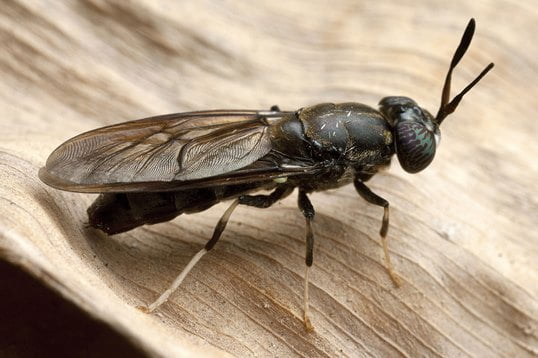
Get Black soldier fly farming course here
What if we told you that you could make your aquafeed or poultry farm feed much more nutritious, organic, rich in absorbable protein and simultaneously bring down the costs associated with feed management in the long run, and also ensure that the feed is managed in an eco-friendly manner? Sounds too good to be true, doesn’t it? Black soldier fly or BSF farming is the newest hot trend in the Indian feed farming scene and the larva is now being adopted as part of livestock diet the world over.
There’s a bunch of reasons that make Black Soldier Fly larva production a favorable agriculture management practice and the ease factor is driving many first-time agripreneurs towards exploring the lesser penetrated market of organic livestock feed production.
BSF is a fly that is not considered a pest like the regular house fly, and its larvae play a similar role to that of redworms – i.e., as essential decomposers. Black Soldier Fly larvae break down organic waste and return nutrients to the soil, and are now being utilized for both macro agriculture management practices (due to their utility as decomposers of organic matter towards making agricultural land fertile) as well as the smaller component of agriculture management that precisely deals with feed management in animal husbandry.
Additionally, given the short lifespan of 6 weeks and immunity to most diseases, farming Black Soldier Flies is much easier than farming any other mealworm, and even beginners can master the skills required in a short duration.
With growing emphasis on watching what one eats, many meat consumers are now not only concerned about where they source their meat-based products from, but also involved in verifying the kind of feed that is fed to the animals that make it onto their plate.
There’s more transparency in feed management practices now than there has ever been, and therefore, organic feed and feed components such as the black soldier fly larva are experiencing exponentially growing demand, with a potential of reaping up to Rs.50,000 a month for the Black Soldier Fly larva farmer. You can now easily learn how to farm black soldier fly larvae from the comfort of your home with specific and detailed online courses that explain the whole process in granular detail and help you connect with industry experts to solve your queries in real-time!
Broadly, there are three stages in the whole Black Soldier Fly larva farming exercise. Let’s look at each of them:
The Breeding Stage
A BSF lays eggs not too long before it is about to die, and can lay up to 500 eggs in one go! During the breeding stage, which is also alternatively known as the hatching phase, the eggs of an adult black soldier fly are deposited into containers that are stacked vertically and filled with compost which is made of organic food waste. It is important to closely control and monitor the climate in this stage as temperatures and moisture would guide the success rate of the hatching process. This process does not take too long and eggs soon take the form of Black Soldier Fly larvae.
The Production Stage
When you compare Black Soldier Fly larva with other mealworms, you’d need about 2 kg of feed on average to convert into 1 kg of mealworms. However, to produce 1 kg BSF larvae, you’ll need only around 1.5 kg of feed, offering a clear advantage over other mealworm varieties. This conversion happens during the production stage.
The production stage refers to growing these larvae to their maximum extent in terms of size and mass, whereafter they can be used as feed component for poultry, fish or animal farms. This process anywhere between a week and 10 days and again, within controlled climate where temperature, moisture and nutrition are carefully monitored, the newly hatched larvae attain their full potential of body mass. Hereafter, these larvae are harvested to be sent into the processing stage which marks the end of the Black Soldier Fly farming process for the purpose of feed production.
The Processing Stage
When the larvae are ready to be harvested, they are constituted of anywhere between 40% to 65% of protein and the rest of their nutritional composition includes essential minerals and other micronutrients, in addition to carbohydrates and fats. The larvae are then dried and further processed to provide an insect meal that is ready for distribution to fish farms and if necessary, sent for any further processing.
Given the wholesome nutrition blend, many people are incorporating larvae into their own diets as well, as a sustainable and eco-friendly (much less usage of water and carbon emission as compared to any major meat industry product) source of protein-rich diet, however, since this trend is not widely practiced, BSF larva-based feed remains predominantly exclusive to animal consumption.
There are various methods that are adopted to farm BSF larvae, mostly depending upon the space at disposal and the general climatic conditions in the area where farming is intended to be done. The feed options are plenty, as these larvae thrive on many types of food wastes, ranging from your kitchen waste to even brewery grain waste, or unimaginably, waste from ethanol production, practically solving your waste disposal problems and feed procurement concerns in one blow!
With low costs and high margins, BSF farming is a great space to venture into. Learn how to start your own BSF farming business today!


